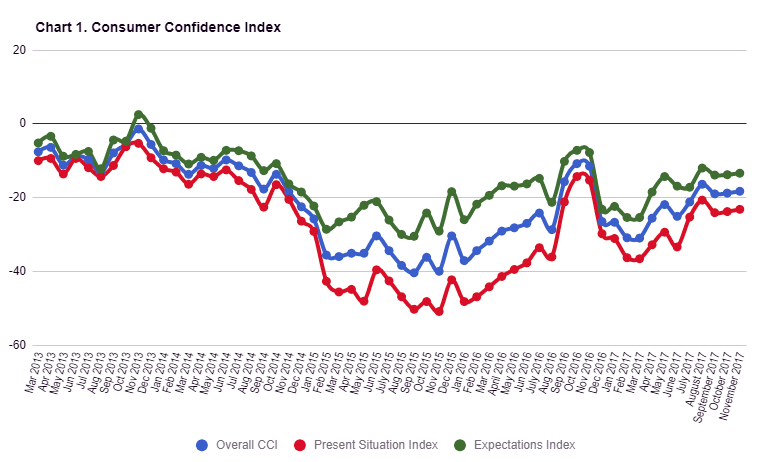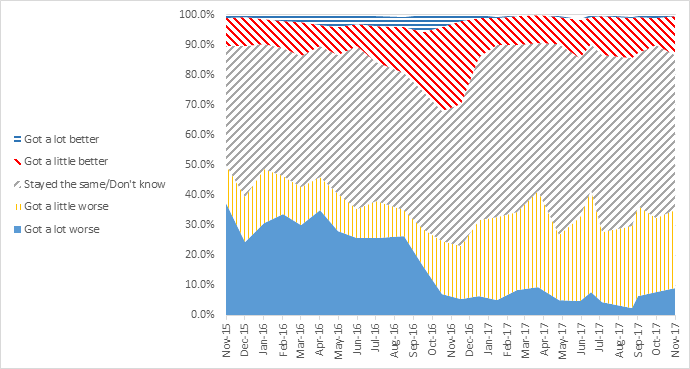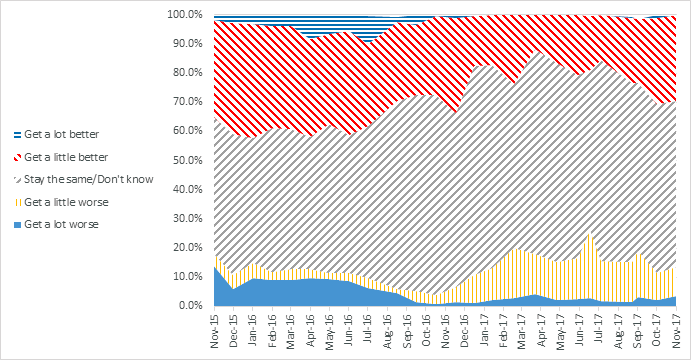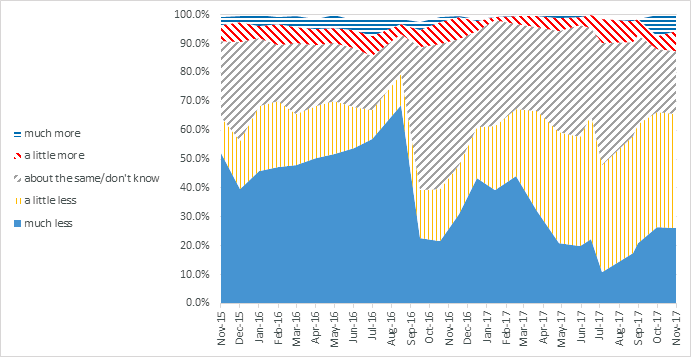2017 is shaping up as one of the best years in Georgia’s post-2008 crisis history. The economy is expected to expand by about 5%, beating early expectations and official forecasts by the likes of the IMF and the World Bank. Based on updated GeoStat figures for Q1 and Q2, ISET-PI’s annual growth forecast currently stands at 4.9%. Even that figure is likely to be revised upwards if Q3 growth turns out to be higher than suggested by GeoStat’s preliminary estimate of 4.4%.
Georgia is not alone in experiencing a boom. In fact, it is rising with a tide affecting the entire region: Turkey’s economy added 11.06% y/y in Q3 2017, Armenia grew by a staggering 17.6% y/y in October 2017, and even Russia appears to have finally turned the corner, adding 2.47% y/y in Q3. Indeed, to a large extent, Georgia’s growth is caused by improvements in the immediate environment: stronger external demand for Georgian tourism and hospitality services, traditional exports (wine, mineral water, food and agricultural products) and labor (as reflected in larger amounts of money sent home by Georgian workers abroad).
Did any of this growth “trickle down” to the level of regular Georgian folks? Did it affect the ability of Georgian households to supply their immediate needs and save for the rainy day?
Georgian Consumer Confidence, as measured by ISET-PI’s nationally representative monthly survey, has been on the rise ever since hitting the bottom at about -40 index points in early fall of 2015. The trend was particularly positive until Sep-Oct 2016 when the CCI peaked at -11-12 index points. In 2017, CCI’s record was more of a mixed bag: it fell quite precipitously to -30.9 points in March 2017, but then started recovering, reaching -18.3 index points by November.
But, was this improvement in consumer confidence somehow related to growth performance?
Not really. In 2016, a year of fast progress in the CCI, Georgia’s GDP grew by a mere 2.7%. Better than in 2014 (1.7%), but a bit worse than in 2015 (2.8%). Conversely, in the second half of 2017, despite impressive growth performance, the CCI has been largely stagnant, hovering around -18-20 index points. Thus, there appears to be very little “transmission” from growth per se to household incomes and domestic consumer sentiment. The reverse is also true: rather than reflecting stronger domestic demand, Georgia’s growth in 2017 has been fueled by stronger demand by consumers in our immediate environment – lovers of Georgian casinos and seaside resorts, folk traditions, centuries-old recipes, mineral waters and wines.
If not economic growth, what could then explain the positive trend we observe in CCI since fall 2015, and, in particular, the dramatic surge in consumer confidence in September and October 2016?
IT IS (EXPECTATIONS OF) REDISTRIBUTION, STUPID!
As has been discussed on these pages in the past, two factors stand out in explaining the dynamics of Georgian consumer confidence in recent 3-4 years. First, the Georgian lari’s exchange rate vis-à-vis major foreign currencies, and second, Georgia’s parliamentary elections.
Much ink has been spent on explaining how the lari’s devaluation has affected the well-being of Georgian households and SMEs. Indeed, as long as GEL continued to devalue, Georgian households had to spend an ever increasing share of their GEL incomes on servicing their dollar-denominated debts. A point that may have been lost on the Georgian public is that GEL’s devaluation was equivalent to a massive redistribution of income from Georgian households to Georgia’s banks. Put simply, every additional GEL in debt servicing costs for Georgian borrowers translated into windfall gains for Georgian lenders who saw their profits swell to hitherto unprecedented levels. And since the Georgian banking sector benefits a miniscule share of Georgian households, no growth in the overall size of the pie could feasibly compensate Georgian consumers for devaluation-induced losses, leading to an unprecedented collapse in consumer confidence.
While GEL devaluation redistributed income from households to Georgia’s major banking groups, Georgia’s democratic elections created expectations of redistribution in reverse, from Georgian businesses to households.
By late 2015, GEL stopped losing value. In December 2015, Georgia had its Kvirikashvili moment. But, expectation have been finally reset in September 2016, when the new PM published a political platform including a spate of pro-poor measures, such as an upgrade of Georgia’s vocational education system, a pension reform raising old-age retirement benefits, and a major upgrade of the road infrastructure, connecting remote rural areas to markets in Tbilisi and other parts of the country.
The share of those reporting that their financial situation got a lot worse during the past 12 months suddenly shrank in Sep-Oct 2016, with many more reporting only some worsening, stability or even some improvement…
Figure 2: How has the financisituation of your household changed over the last 12 months?
Expectations regarding the future have been also reset with many more people expecting their financial situation to get only a little worse or stay the same.
Figure 3: How do you expect the financial position of your household to change over the next 12 months?
A most dramatic change occurred in people’s expectations concerning major purchases…
Figure 4: Compared to the past 12 months, do you expect to spend more or less money on major purchases
People stopped disbelieving their ability to save, at least a little…
Figure5: Over the next 12 months, how likely is it that you save any money?
People started reporting to be much less likely to run into debt…
Figure 6: Which of these statements best describes the current financial situation of your household?
As we have seen above, progress in Georgian consumers’ confidence has stalled in recent months despite faster economic growth. This has everything to do with a resumption of devaluation pressures and the government’s inability to quickly deliver on the promise to redistribute from those who have (everything) to those have less or nothing at all. Ambitious measures, such as vocational education and pension reforms, will take years to implement, let alone improve the lot of the poor. In the meantime, we have no choice but hope that Georgia’s economic growth will somehow start trickling down, benefiting those in need and improving consumer sentiment.
MONTHLY AND YEARLY CHANGES IN THE CCI VARIABLES
BAR CHARTS: CONSUMER RESPONSES BY QUESTIONS
| ; | |














